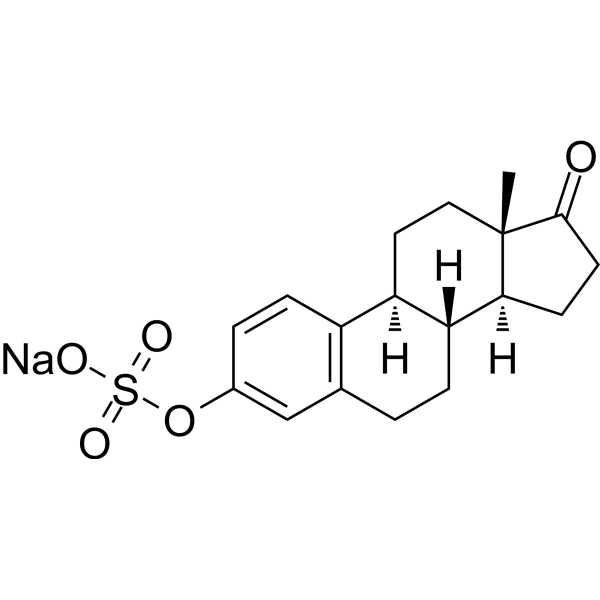
Estrone sulfate sodium
CAS No. 438-67-5
Estrone sulfate sodium( Estrone 3-sulfate (sodium salt) | 17β-Estrone 3-sulfate )
Catalog No. M28098 CAS No. 438-67-5
Estrone 3-sulfate is an endogenous steroid and an estrogen ester that is biologically inactive. It is converted by steroid sulfatase into estrone.
Purity : >98% (HPLC)
 COA
COA
 Datasheet
Datasheet
 HNMR
HNMR
 HPLC
HPLC
 MSDS
MSDS
 Handing Instructions
Handing Instructions
| Size | Price / USD | Stock | Quantity |
| 5MG | 224 | Get Quote |


|
| 10MG | 336 | Get Quote |


|
| 25MG | 710 | Get Quote |


|
| 50MG | 1116 | Get Quote |


|
| 100MG | 1692 | Get Quote |


|
| 200MG | 2574 | Get Quote |


|
| 500MG | Get Quote | Get Quote |


|
| 1G | Get Quote | Get Quote |


|
Biological Information
-
Product NameEstrone sulfate sodium
-
NoteResearch use only, not for human use.
-
Brief DescriptionEstrone 3-sulfate is an endogenous steroid and an estrogen ester that is biologically inactive. It is converted by steroid sulfatase into estrone.
-
DescriptionEstrone 3-sulfate is an endogenous steroid and an estrogen ester that is biologically inactive. It is converted by steroid sulfatase into estrone . Estrone 3-sulfate has been investigated as a ligand for targeting organic anion transporting polypeptides.
-
In Vitro——
-
In Vivo——
-
SynonymsEstrone 3-sulfate (sodium salt) | 17β-Estrone 3-sulfate
-
PathwayProteasome/Ubiquitin
-
TargetEndogenous Metabolite
-
RecptorEP4
-
Research Area——
-
Indication——
Chemical Information
-
CAS Number438-67-5
-
Formula Weight372.41
-
Molecular FormulaC18H21NaO5S
-
Purity>98% (HPLC)
-
SolubilityIn Vitro:?DMSO : 25 mg/mL (67.13 mM)
-
SMILES[Na+].C[C@]12CCC3C(CCc4cc(OS([O-])(=O)=O)ccc34)C1CCC2=O
-
Chemical Name——
Shipping & Storage Information
-
Storage(-20℃)
-
ShippingWith Ice Pack
-
Stability≥ 2 years
Reference
1.Cherukuri DP, et al. The EP4 receptor antagonist, L-161,982, blocks prostaglandin E2-induced signal transduction and cell proliferation in HCA-7 colon cancer cells.Exp Cell Res.?2007 Aug 15;313(14):2969-79.
molnova catalog



related products
-
3-Nitro-L-tyrosine
3-Nitrotyrosine is the major product from the spontaneous reaction of peroxynitrite with tyrosine. Formation of nitrotyrosine can indicate the formation of peroxynitrite by a nitric oxide (NO)-dependent oxidative damage.
-
Neopterin
D-(+)-Neopterin is produced by human monocytes/macrophages upon stimulation with the cytokine interferon-γ. In humans, neopterin is involved in purine biosynthesis.
-
D-DELTA-TOCOPHEROL
D-DELTA-TOCOPHEROL is an isomer of Vitamin Ehas antioxidant activityand might be useful as effective ingredients in whitening cosmetics with lower skin toxicity.



 Cart
Cart
 sales@molnova.com
sales@molnova.com


